New Zealand 1993 "Dinosaurs"
| <prev |
| Issue Date | 01.10.1993 |
| ID | Michel: 1314, 1315-1319, Bl.39, 39I; Scott: 1180-1184, 1184a; Stanley Gibbons: 1762-1767, 1768; Yvert et Tellier: 1247-1251, 1252, 90, 92; Category: pR |
| Designer | Geoffrey Cox, Auckland, NZ |
| Stamps in set | 6 |
| Value |
45c - Booklet stamp:
Sauropod and
Carnosaur 45c - Sauropod 80c - Pterosaur $1.00 - Ankylosaur $1.20 - Mauisaurus $2.80 - Carnosaur |
| Emission/Type | commemorative |
| Issue place | Wanganui |
| Size (width x height) | stamps: 28 mm x 40 mm, Souvenir-Sheet: 124 mm x 99 mm |
| Layout | 100 stamps in sheet |
| Products | FDC x 2, Souvenir-Sheet x 1, Booklet x1 |
| Paper | Harrison and Sons, red phosphor coated, unwatermarked |
| Perforation | Sheet stamps: 13.5, Booklet stamp: 12, Miniature Sheet stamp: 14.5 x 14 |
| Print Technique | Lithography |
| Printed by | Southern Colour Print, Dunedin, New Zealand |
| Quantity | |
| Issuing Authority | New Zealand Post |
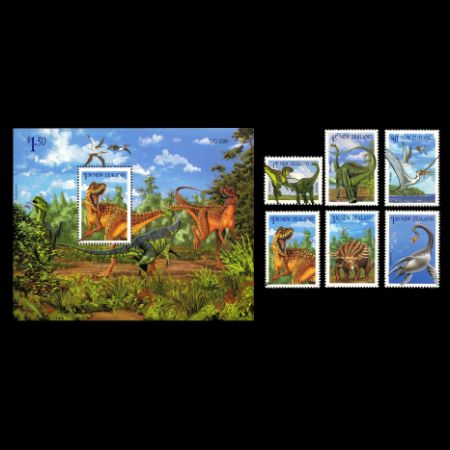
On January 10th, 1993, the Post Authority of New Zealand issued a set of 6 stamps and a Souvenir Sheet that shows various prehistoric animals.
The design of these stamps was based on illustrations of New Zealand's artist Geoffrey Cox. In 2008, the Marshall Islands Postal Service issued the Mini-Sheet with 12 stamps of "Dinosaurs", based on illustrations of Geoffrey Cox too.
New Zealand Post issued 1 stamp from the set in a booklet of 10. The other stamps in the issue were printed in individual sheets of 100. The colourful Souvenir-Sheet incorporates the $1.50 stamp from the issue and depicts a lively scene showing a conflict between two Carnosaurs and a pair of Hypsilophodonts.
Between 1-10 October, 1993, stamp collectors, postal administrations and exhibitors flocked to Thailand to attend the Bangkok '93 World Philatelic Exhibition, where New Zealand Post presented an overprinted Dinosaur souvenir sheet to commemorate the event.
Even though the stamps set was called "Dinosaurs" not all prehistoric animals depicted on the stamps are dinosaurs. Dinosaurs per definition are terrestrial animals. The pterosaurs are flying reptiles and plesiosaurs (Mauisaurus) are marine reptiles.
They came in all shapes and sizes (some were as small as chickens, while others were as tall as five-storey buildings) and they displayed a wide range of social behaviour patterns (some were gentle in nature and ate plant life, while others were violent and threatening, and ate those that ate the plant life!).
The name 'dinosaur' originates from a combination of two Greek words: 'deinos' meaning terrible and 'sauros' meaning lizard. The term was introduced by prominent British paleontologist Sir Richard Owen in 1841. By coining the term in his report, Owen refers to dinosaurs instead as 'fearfully great', acknowledging their large size - significantly surpassing that of any living reptile.
It is these 'terrible lizards' - in particular those that once walked on New Zealand soil - that are the subject of this stamp issue.
Fossils of prehistoric marine reptiles were known in New Zealand since 1861, when Professor Owen communicated to the British Association a brief description of certain fossils that had been discovered by Mr. T. H. Cockbvirn Hood, P.G.S., and presented by him to the British Museum.
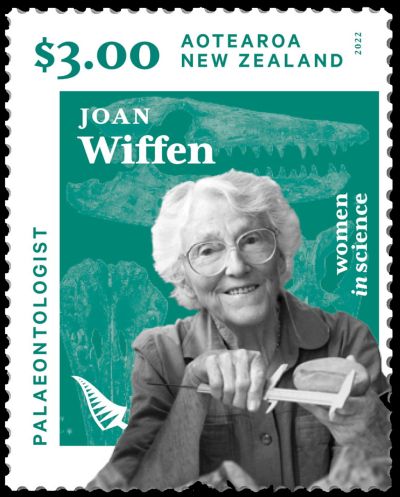 |
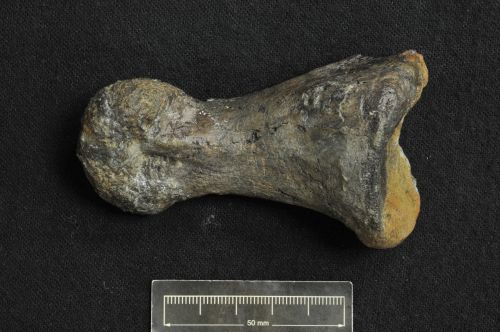 |
| Paleontologist Joan Wiffen stamp of New Zealand 2022, MiNr.: 3974, Scott: 3052. |
The theropod bone found by Joan Wiffen in 1975. Image credit: the Institute of Geological and Nuclear Sciences (GNS). |
When she showed it to another palaeontologist, she learned it was part of the backbone of a carnivorous dinosaur.
In that moment, the long held belief that dinosaurs had never roamed New Zealand, because the country had been isolated from other lands for so long, was shattered.
Over the next few years, Joan Wiffen uncovered more dinosaur fossils and remains of a pterosaur.
Unfortunately, every discovery so far (2022) has been of isolated bones, making complete identification impossible.
As a result, New Zealand dinosaurs have not been given scientific names but general descriptions such as 'carnosaur' and 'sauropod' - the equivalent of describing a modern animal as a 'cat' or 'horse' rather than 'tiger' or 'zebra'.
Prehistoric animals of the stamps
45c - Sauropod45c - Booklet stamp: a Carnosaur attacks a sauropod
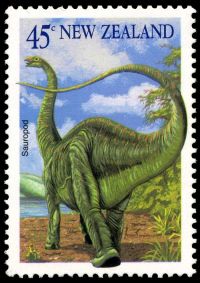 |
| Sauropod on stamp of New Zealand 1993. MiNr.: 1315, Scott: 1180 |
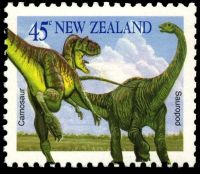 |
| Booklet stamp of New Zealand 1993: Carnosaur attack Sauropod. MiNr.: 1314, Scott: 1185 |
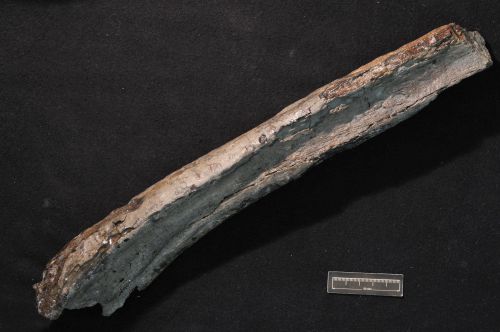 |
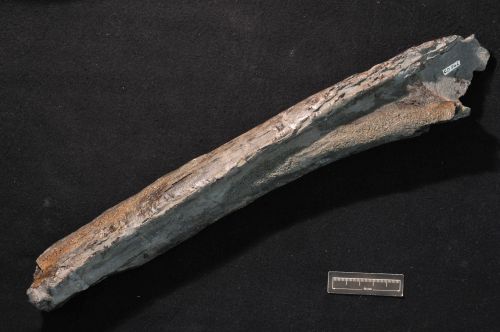 |
|
Sauropod bone discovered by Joan Wiffen at Mangahouanga Stream.
Dimension - length: 390mm, width: 70mm (length), Height: 50mm (length). Image credit: the Institute of Geological and Nuclear Sciences (GNS). |
In 1999, Joan Wiffen discovered a single large caudal vertebra, identified as belonging to a titanosaurid, adding to the scarce record of these giants in Aotearoa New Zealand.
The New Zealand sauropod was much smaller than Apatosaurus - probably about the size of a large elephant.
At the date of the stamp issue, a Sauropod of New Zealand was identified from a piece of rib, which would originally have been 1 to 2 meters long.
The fossil is so distinctive in terms of its size and shape that it can be confidently assigned to a titanosaurid, but more information is necessary to make a more specific determination of the genus or species to which this bone belongs.
It came from an animal that was about eight metres in length.
In 2009 some footprints of sauropods, thought to be about 70 million years old, were discovered in the north-west Nelson region. The discovery of the first dinosaur footprints ever found in New Zealand and the first evidence of dinosaurs in the South Island has amazed scientists around the world.
The giant dinosaur was a herbivore that used its long giraffe-like neck to graze on lush tree top vegetation and lived in herds.
80c - Pterosaur
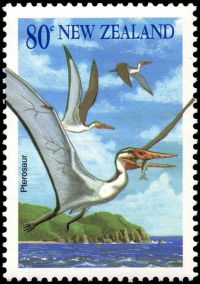 |
| Pterosaur on stamp of New Zealand 1993. MiNr.: 1316, Scott: 1181 |
More recently, with the advent of very high-power microscopes, some “hair-like” structures, preserved in the fossils record, have been interpreted as monofilamentous feathers (feathers like the down on a baby chick).
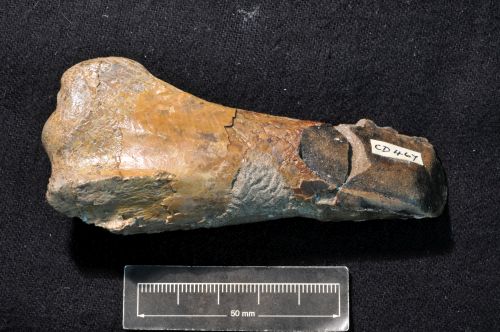 |
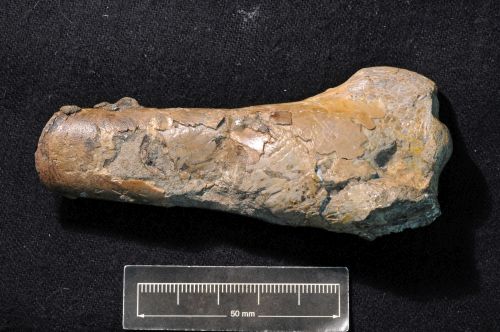 |
|
The first described Pterosaur bone from New Zealand.
It was discovered by Trevor Crabtree at Mangahouanga Stream in 1985.
Described by Joan Wiffen and Dr. Ralph Molnar in their
paper "First pterosaur from New Zealand" in 1988. Image credit: the Institute of Geological and Nuclear Sciences (GNS). |
In 1985, amateur palaeontologist Mr. Trevor Crabtree stumbled on an unusual bone at Mangahouanga Stream on the North Island of New Zealand.
The delicate layered bone looked to be that of a bird. Painstaking cleaning and consultation with overseas authorities showed it to be something more astounding: the lower wing bone (distal) of a pterosaur.
This was the first evidence of a pterosaur from New Zealand, the third from the Late Cretaceous of the southern hemisphere, and represents the extreme southern occurrence of a pterosaur.
In 1988, amateur palaeontologist from New Zealand Mrs. Joan Wiffen and vertebrate palaeontologist Dr. Ralph Molnar from the Queensland Museum, Australia, published an article about the bone. "First pterosaur from New Zealand" was printed in the Australian palaeontology journal "Alcheringa".
They estimated the age of these fossils as equivalent to Campanian-Maastrichtian stages (70.6 million years ago) of the Late Cretaceous. This age estimation was based on molluscan fossils found in boulders derived from the local sandstone of the Mata Series and collected from Mangahouanga Stream, where the fossil was discovered. These beds were deposited on the continental shelf, apparently under shallow, near-shore conditions.
Wiffen and Molnar found some similarity of the bone to the distal bone of the Brazilian pterosaur Santanadactylus araripensis (named after the Araripe Plateau), who had an estimated wingspan of 4 meters. However, relationships of this pterosaur were difficult to determine in the relative absence of comparative materials.
The Crabtree's fossil is the first described pterosaur fossil from New Zealand, but it is perhaps, not the first pterosaur fossil discovered in the country. In 1955, Sir Charles Fleming discovered a piece of bone that has been unofficially identified as that of a pterosaur, from Mikonui Stream, Canterbury. However, the Fleming’s specimen has not been formally identified and described yet (2022).
$1.0 - Ankylosaur
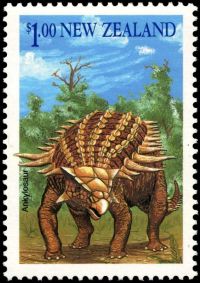 |
| Ankylosaur on stamp of New Zealand 1993. MiNr.: 1317, Scott: 1182 |
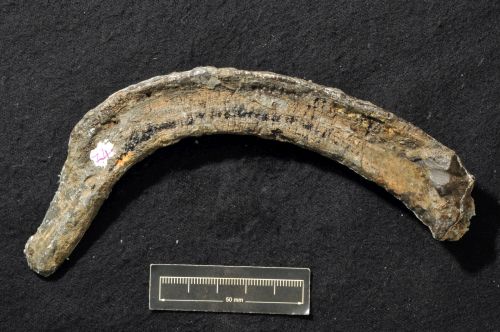 |
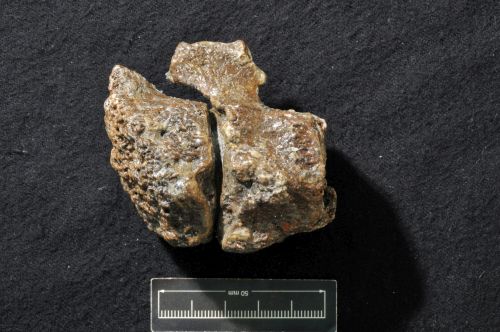 |
|
Ankylosaurian bones discovered by Joan Wiffen at Mangahouanga Stream.
Dimension - length: 160mm, width: 70mm (length), Height: 25mm (length) Image credit: the Institute of Geological and Nuclear Sciences (GNS). |
Ankylosaurs were bulky quadrupeds, with short, powerful limbs. Its head was square and flat and was broader than it was long. Its teeth, like those of the related stegosaurs, consisted of a simple curved row of irregularly edged (crenulated) leaf-shaped teeth.
Ankylosaurids’s long tail terminated in a thick “club” of bone, which it probably swung as a defence against predators. This club was formed by the last tail vertebrae, which were nested tightly against each other and a sheath of several bony plates.
Although a slow-moving herbivore, Ankylosaur presented anything but an easy target for meat-eating dinosaurs; heavy bone armour, coupled with bony horns across its back and head, saw to that.
Ankylosaur were up to three metres long and weighed around half a tonne.
They are known to have first appeared in the Middle Jurassic, and persisted until the end of the Cretaceous Period. The two main families of Ankylosaurs, Nodosauridae and Ankylosauridae are primarily known from the Northern Hemisphere, but the more basal Parankylosauria are known from southern Gondwana during the Cretaceous.
Ankylosauria was first named by Henry Fairfield Osborn in 1923.
To the date of the stamp issue, Ankylosaur fossils of New Zealand were represented by two tail vertebra and a piece of a flattened rib. All three bones were discovered by Joan Wiffen in 1998.
$1.20 - Mauisaurus
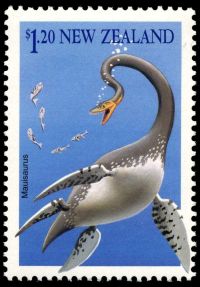 |
| Mauisaurus on stamp of New Zealand 1993. MiNr.: 1318, Scott: 1183 |
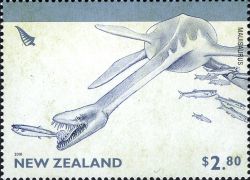 |
| Mint and self-adhesive Mauisaurus stamps from "Ancient Reptiles of New Zealand" stamps set from 2010, MiNr.: 2672/2679, Scott: |
The neck posture was correct on the New Zealand's stamp of 2010 (see on the right).
The vertebrae were rather short and there was very little space between the centers of the vertebrae. Their dorsal spines were very long and broad, which reduced the amount of possible vertical movement a lot. Unlike those of many other long-necked animals, the individual neck vertebrae on plesiosaurs were not particularly elongated; rather, the extreme neck length was achieved by a much increased number of vertebrae. Elasmosaurus's neck could reach up to 60% of the entire length of the animal by having 72 neck or cervical vertebrae.
The weight of its long neck placed the center of gravity behind the front flippers. Thus, Elasmosaurus could have raised its head and neck above the water only when in shallow water, where it could rest its body on the bottom. The weight of the neck, the limited musculature, and the limited movement between the vertebrae would have prevented Elasmosaurus from raising its head and neck very high.
The statement that "plesiosaurs probably came ashore to lay their eggs, burying them in the sand of beaches, as modern turtles do" from the booklet, issued by New Zealand's post in 1993, designed by Geoffrey Cox, is outdated, according to recent research.
In 2011, a plesiosaur fossil of an adult female with a fetus inside it (both were identified as the same species - Polycotylus latippinus) was reported by F. Robin O’Keefe of Marshall University in Huntington, West Virginia, USA.
As there is also no evidence that the adult ate the juvenile, such as damage from stomach acid or chewing, O’Keefe suggested that the long-necked plesiosaurs that roamed the seas during the dinosaur era gave birth to live young.
They probably cared for their offspring and may even have lived in large social groups, like modern-day whales.
O’Keefe says it’s not surprising that plesiosaurs gave live birth: reptilian eggs are hard-shelled and must be laid on land, and plesiosaurs were too big to clamber out onto the shore.
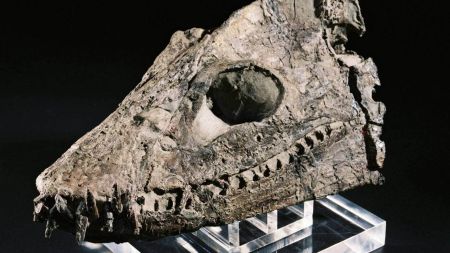 |
| This elasmosaurus skull was discovered by the late Joan Wiffen in the Urewera range. Image credit: the Institute of Geological and Nuclear Sciences (GNS) |
Elasmosaurus fossils have been found in marine sedimentary rocks (mainly sandstone and siltstone) of Late Cretaceous age, between 100 and 65 million years ago, all over the world.
This superb specimen was discovered by Joan Wiffen and her colleagues at Mangahouanga Stream, Te Hoe Valley, Hawke's Bay.
It was subsequently prepared and described by Joan Wiffen and vertebrate palaeontologist Dr Ralph Molnar, and formally named Tuarangisaurus keyesi.
The genus name relates to its New Zealand origins and means 'lizard from Tuarangi'.
The species name honours Ian Keyes, a skilled fossil preparator, palaeontologist and curator with New Zealand Geological Survey, and a significant mentor to Joan Wiffen.
As with all other fossils at this locality, it is derived from the Maungataniwha Sandstone.
$1.50 - Carnosaur
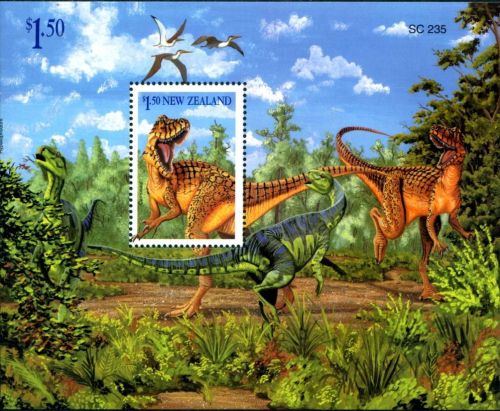 |
| Carnosaurs hunt Hypsilophodonts on Souvenir-Sheet of New Zealand 1993. MiNr.: Bl. 39, Scott: 1184a |
Carnosaur was depicted on an individual stamp and on the stamp in the Souvenir-Sheet.
A fearsome flesh eater, Carnosaur weighed about two tonnes and may well have been capable of speeds as fast as 50 kilometres per hour.
It walked on its hind legs, had powerful clawed hands. An adult human would barely have reached the largest Carnosaur's thigh.
Two Carnosaurs are featured on the Souvenir-Sheet produced with this issue, once on the stamp and another one on the margin - this time attacking a pair of Hypsilophodonts.
Hypsilophodonts were the gazelles of the dinosaur world - small, fleet-footed herbivores without defensive armour or weapons.
The specimen found in New Zealand was about three metres long and is known from part of its pelvis.
Part of the hip of Hypsilophodont was discovered by Joan Wiffen.
There is evidence the "gazelle-like" creatures, which probably wandered in herds, lived on both the North and South Islands.
Products
| FDC | ||
| Regular stamps | Souvenir-Sheet stamps | Booklet stamps |
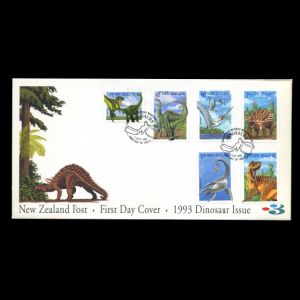 |
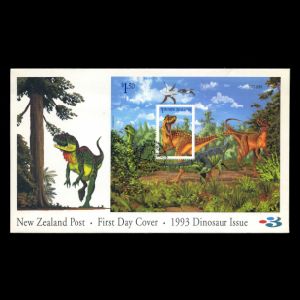 |
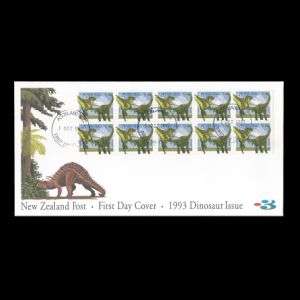 |
| FDC autographed by the designer of the stamps | Personalized FDCs | Surcharged Souvenir-Sheet |
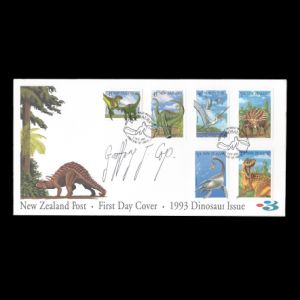 |
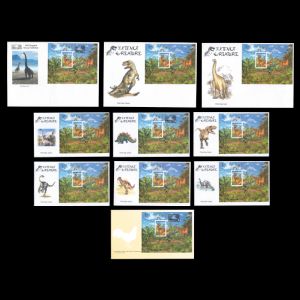 |
 |
| Booklet | Example of circulated covers | |
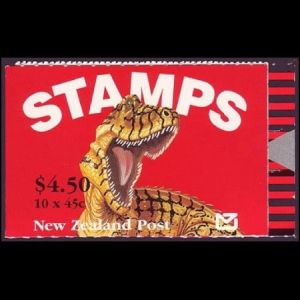 |
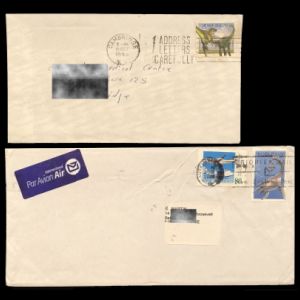 |
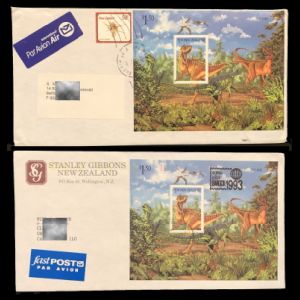 |

|
References
- Technical details and release notes:
NZpost, Focus Magazine form April 13, 1993, Virtual New Zealand Stamps. - Fossils discoveries in New Zealand: NZ Geo, OTAGO, BBC.
- Sauropoda discoveries in New Zealand: Wikipedia, Science Learning Hub,
- Pterosaur discoveries in New Zealand: nzherald, NZ Geo, Pterodata, Ralph_Molnar (Wikipedia).
- Ankylosaurus discoveries in New Zealand: Wikipedia, Encyclopedia Britannica,
- Mauisaurus discoveries in New Zealand: The History of Ichthyosaurs Discovery, New Scientist.
- Carnosaurus discoveries in New Zealand: Wikipedia, Encyclopedia Britannica,
- Hypsilophodont discoveries in New Zealand: Wikipedia, Stuff.
Acknowledgements
Many thanks to
- Dr. Peter Voice from Department of Geological and Environmental Sciences, Western Michigan University, for reviewing the draft page and his very valuable comments.
- Marianna Terezow, Manager – National Paleontological Collection, GNS Science for reviewing the draft page, providing images, and her very valuable comments.
| <prev |